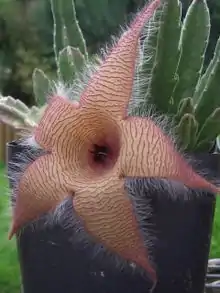Asclepiadoideae
The Asclepiadoideae are a subfamily of plants in the family Apocynaceae. Formerly, they were treated as a separate family under the name Asclepiadaceae, e.g. by APG II, and known as the milkweed family. [2][3]
| Asclepiadoideae | |
|---|---|
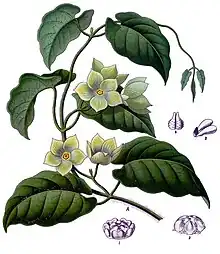 | |
| Matelea denticulata[1] | |
| Scientific classification | |
| Kingdom: | Plantae |
| Clade: | Tracheophytes |
| Clade: | Angiosperms |
| Clade: | Eudicots |
| Clade: | Asterids |
| Order: | Gentianales |
| Family: | Apocynaceae |
| Subfamily: | Asclepiadoideae Burnett |
| Genera | |
|
See text | |
They form a group of perennial herbs, twining shrubs, lianas or rarely trees but notably also contain a significant number of leafless stem succulents. The name comes from the type genus Asclepias (milkweeds).
There are 348 genera, with about 2,900 species. They are mainly located in the tropics to subtropics,[4] especially in Africa and South America.
The florally advanced tribe Stapelieae within this family contains the relatively familiar stem succulent genera such as Huernia, Stapelia and Hoodia. They are remarkable for the complex mechanisms they have developed for pollination, which independently parallel the unrelated Orchidaceae, especially in the grouping of their pollen into pollinia. The fragrance from the flowers, often called "carrion", attracts flies. The flies pollinate the flowers.
Many new hybrids have been formed due to the unique fertilization method of the flowers.
Tribes and genera
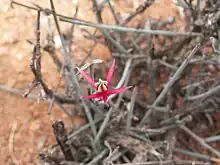
In 2014, Endress, Liede-Schumann and Meve recognised five tribes. Some of the genera they accepted are regarded as synonyms by other sources.[5]
Asclepiadeae
- Adelostemma Hook.f.
- Aidomene Stopp
- Araujia Brot.
- Asclepias L.
- Aspidoglossum E.Mey.
- Aspidonepsis Nicholas
- Astephanus R.Br.
- Barjonia Decne.
- Blepharodon Decne.
- Calciphila Liede
- Calotropis R.Br.
- Cordylogyne E.Mey.
- Cynanchum L.
- Diplolepis R.Br.
- Ditassa R.Br.
- Fanninia Harv.
- Fischeria DC.
- Funastrum E.Fourn.
- Glossonema Decne.
- Glossostelma Schltr.
- Gomphocarpus R.Br.
- Gonolobus Michx.
- Graphistemma (Champ.
- Gyrostelma E.Fourn.
- Hemipogon Decne.
- Holostemma R.Br.
- Hypolobus E.Fourn.
- Ibatia Decne.
- Jobinia E.Fourn.
- Kanahia R.Br.
- Lachnostoma Kunth
- Macroscepis Kunth
- Mahawoa Schltr.
- Margaretta Oliv.
- Matelea Aubl.
- Merrillanthus Chun
- Metaplexis R.Br.
- Metastelma R.Br.
- Microloma R.Br.
- Minaria T.U.P.Konno
- Miraglossum Kupicha
- Monsanima Liede
- Morrenia Lindl.
- Nautonia Decne.
- Nephradenia Decne.
- Odontanthera Wight
- Odontostelma Rendle
- Oncinema Arn.
- Orthosia Decne.
- Oxypetalum R.Br.
- Oxystelma R.Br.
- Pachycarpus E.Mey.
- Parapodium E.Mey.
- Pentacyphus Schltr.
- Pentarrhinum E.Mey.
- Pentastelma Tsiang
- Pentatropis R.Br.
- Peplonia Decne.
- Pergularia L.
- Petalostelma E.Fourn.
- Phaeostemma E.Fourn.
- Pherotrichis Decne.
- Philibertia Kunth
- Pseudolachnostoma Morillo
- Raphistemma Wall.
- Rhyssostelma Decne.
- Rhytidostemma Morillo
- Rojasia Malme
- Schizoglossum E.Mey.
- Schizostephanus Hochst.
- Schubertia Mart.
- Scyphostelma Baill.
- Seshagiria Ansari
- Sichuania M.G.Gilbert
- Solenostemma Hayne
- Stathmostelma K.Schum.
- Stelmagonum Baill.
- Stenomeria Turcz.
- Stenostelma Schltr.
- Tassadia Decne.
- Trachycalymma (K.Schum.)
- Tweedia Hook.
- Tylodontia Griseb.
- Vincetoxicum Wolf
- Widgrenia Malme
- Woodia Schltr.
- Xysmalobium R.Br.
Ceropegieae
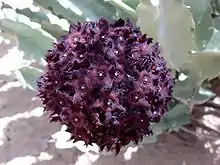

- Anisotoma Fenzl
- Anomalluma Plowes
- Apteranthes J.C.Mikan
- Australluma Plowes
- Baynesia Bruyns
- Boucerosia Wight
- Brachystelma Sims
- Caralluma R.Br.
- Caudanthera Plowes
- Ceropegia L.
- Conomitra Fenzl
- Desmidorchis Ehrenb.
- Duvalia Haw.
- Duvaliandra M.G.Gilbert
- Echidnopsis Hook.f.
- Edithcolea N.E.Br.
- Emplectanthus N.E.Br.
- Heterostemma Wight
- Hoodia Sweet
- Huernia R.Br.
- Larryleachia Plowes
- Lavrania Plowes
- Leptadenia R.Br.
- Monolluma Plowes
- Neoschumannia Schltr.
- Notechidnopsis Lavranos
- Ophionella Bruyns
- Orbea Haw.
- Orbeanthus L.C.Leach
- Orthanthera Wight
- Pectinaria Haw.
- Pentasacme Wall.
- Piaranthus R.Br.
- Pseudolithos P.R.O.Bally
- Quaqua N.E.Br.
- Rhytidocaulon P.R.O.Bally
- Richtersveldia Meve
- Riocreuxia Decne.
- Sisyranthus E.Mey.
- Socotrella Bruyns
- Stapelia L.
- Stapelianthus Choux
- Stapeliopsis Pillans
- Tavaresia Welw.
- Tridentea Haw.
- Tromotriche Haw.
- Whitesloanea Chiov.
Eustegieae
- Eustegia K.Schum. & Schltr.
- Emicocarpus R.Br.
Marsdenieae
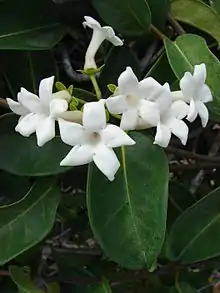
- Anatropanthus Schltr.
- Anisopus N.E.Br.
- Asterostemma Decne.
- Campestigma Pierre
- Cathetostemma Blume
- Cionura Griseb.
- Cosmostigma Wight
- Dischidia R.Br.
- Dolichopetalum Tsiang
- Gongronema (Endl.)
- Gunnessia P.I.Forst.
- Gymnema R.Br.
- Heynella Backer
- Hoya R.Br.
- Jasminanthes Blume
- Lygisma Hook.f.
- Marsdenia R.Br.
- Oreosparte Schltr.
- Pycnorhachis Benth.
- Rhyssolobium E.Mey.
- Sarcolobus Thouars
- Stephanotis Schltr.
- Stigmatorhynchus Coville
- Telosma Hook.f.
- Treutlera Hassk.
- Wattakaka
References
- 1897 illustration from Franz Eugen Köhler, Köhler's Medizinal-Pflanzen
- English Names for Korean Native Plants (PDF). Pocheon: Korea National Arboretum. 2015. p. 363. ISBN 978-89-97450-98-5. Archived from the original (PDF) on 25 May 2017. Retrieved 25 January 2017 – via Korea Forest Service.
- Endress, M. E. and P. V. Bruyns (2000), "A revised classification of the Apocynaceae s.l." (PDF), Botanical Review, 66 (1): 1–56, doi:10.1007/BF02857781
- Spellenberg, Richard (2001) [1979]. National Audubon Society Field Guide to North American Wildflowers: Western Region (rev ed.). Knopf. p. 347. ISBN 978-0-375-40233-3.
- Endress, Mary E.; Liede-Schumann, Sigrid; Meve, Ulrich (February 2014). "An updated classification for Apocynaceae". Phytotaxa. 159 (3): 175–194. doi:10.11646/phytotaxa.159.3.2. ISSN 1179-3163.


